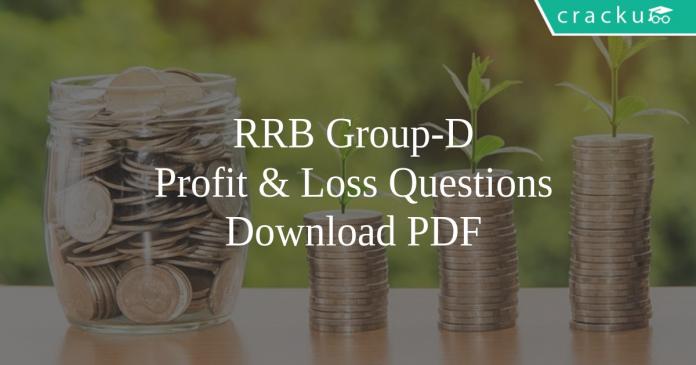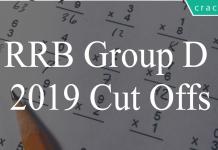RRB Group-D Profit & Loss Questions PDF
Download Top 20 RRB Group-D Profit & Loss Questions and Answers PDF. RRB Group-D Maths questions based on asked questions in previous exam papers very important for the Railway Group-D exam.
Download RRB Group-D Profit & Loss Questions PDF
Download RRB Group-D Previous Papers PDF
Take a RRB Group-D free mock test
Question 1: Ratnesh is a fruit seller and he sells mangoes and oranges. Cost price of 4 mangoes is same as selling price of 3 oranges. The selling price of 3 mangoes is same as cost price of 4 oranges. What is the profit percentage made by Ratnesh by selling 12 mangoes and 12 oranges?
a) 24 percent
b) 25 percent
c) 33.33 percent
d) 20 percent
Question 2: A juice seller sells one glass of juice at Rs. 50 but costs him only Rs. 38. Further, if the seller uses only 80% of juice and remaining quantity as water, which is free, what will be his actual approximate profit percentage?
a) 64.47%
b) 82%
c) 67.71%
d) 78.2%
Question 3: Mukesh purchased three equally priced chairs at a total cost of Rs. 3720. He sold one chair at 30% profit and other two chairs at 12% loss and 16% loss respectively. What will be profit or loss for Mukesh?
a) Rs. 32.4
b) Rs. 27.8
c) Rs. 24.8
d) Rs. 26.2
Question 4: Ram sold a fridge for Rs. 4851 and incurred a loss of 23%. At what price should Ram sell the fridge to realise 18% profit?
a) Rs. 6300
b) Rs. 8000
c) Rs. 7434
d) Rs. 8564
Question 5: A milkman adds water to the milk in the ratio 1 : 4 and sells the mixture at the cost price of milk. However, after realizing that the quality of milk has deteriorated, customers forced the milkman to reduce the price of milk by 20%. In what ratio shall the milkman add water to the milk now so that his profit remains same? (Assume water to be freely available)
a) 5 : 13
b) 3 : 7
c) 7 : 17
d) 9 : 16
Take a free mock test for RRB Group-D
Question 6: Satish bought two articles at the same price. He sold one of them at 27% profit and one at 39% loss. What is his net profit/loss percentage?
a) 12% loss
b) 12% profit
c) 6% profit
d) 6% loss
Question 7: A trader mixed three varieties of rice A, B and C in the ratio 2 :1: 3. The cost prices of rice A, B and C are Rs. 90, Rs. 110 and Rs. 70 respectively. At what rate must he sell the mixture to gain a profit of 12%?
a) Rs. $99\frac{1}{3}$ per kg
b) Rs. $93\frac{2}{3}$ per kg
c) Rs. $96\frac{1}{3}$ per kg
d) Rs. $93\frac{1}{3}$ per kg
Question 8: A milkman sells one litre of milk at Rs. 60 which costs him Rs. 48. If he adds 20% water, which is available for free, to one litre of milk and sells the mixture at the same cost, what will be his actual profit percentage?
a) 65%
b) 40%
c) 50%
d) 55%
Question 9: Raja bought toffees at the rate 6 toffees for Rs. 5 and sold them at the rate of 5 toffees for Rs 6. What is his net profit/loss?
a) 50% profit
b) 44% loss
c) 44% profit
d) 50% loss
Question 10: Abhi bought three articles at the same price. He sold two of them at 20% profit and one at 30% loss. What is his net profit/loss?
a) 5% loss
b) 6.66% profit
c) 3% loss
d) 3.33% profit
RRB Group D previous year papers
Question 11: A retailer marked the price 25% higher than the cost price and then offered two successive discounts of 10% each. What is his net profit/loss?
a) 2.5% profit
b) 1.25% profit
c) 3% loss
d) 5% loss
Question 12: Aman sold his cycle at a loss of 10%. Had he sold the cycle at Rs. 112 more than the current selling price, he would have gained 10%. What would be the selling price of the cycle in order to have a profit 25%?
a) Rs. 800
b) Rs. 700
c) Rs. 500
d) Rs. 600
Question 13: Mukesh bought a computer with 40% discount on the marked price. He sold it at a gain of 70% on the price he bought. What was his profit percentage on the marked price?
a) 2.5%
b) 2%
c) 3%
d) 3.5%
770 Mocks (cracku Pass) Just Rs.199
Question 14: The marked price of an article is Rs 1200 and retailer gets a discount of 25%. If he sells that article for Rs 1200, then what is the profit percentage of retailer?
a) 33.33
b) 25
c) 37.5
d) 16.66
Question 15: On selling 56 chairs, Mohan earns profit equal to the selling price of 6 chairs. What is the profit percentage?
a) 9.28
b) 10.71
c) 12
d) 13.7
Question 16: A merchant marks the price of his articles 20% above the cost price. If he allows 20% discount, then what is the profit or loss percentage?
a) 2% loss
b) 4% profit
c) 4% loss
d) No profit/loss
RRB Group-D Important Questions (download PDF)
Question 17: X, Y and Z are partners in a company. In one year X receives 1/4 part of profit, Y receives 1/5 part of profit and Z receives Rs 22000. How much amount (in Rs) will X get as profit?
a) 10000
b) 12000
c) 15000
d) 18000
Question 18: The marked price of an article is 60% more than its cost price. What maximum discount percentage can be offered by the shopkeeper to sell his article at no profit or no loss?
a) 37.5
b) 62.5
c) 50
d) 25
Question 19: If A purchase 9 chairs for Rs 5 and sells all the chairs at the rate of 5 chairs for Rs 9, then what will be the profit percentage?
a) 212
b) 224
c) 248
d) 194
Question 20: Cost price of an article is Rs 122. If profit percentage is 56%, then what is the selling price (in Rs) of the article?
a) 277.27
b) 217.85
c) 175.68
d) 190.32
General Science Notes for RRB Exams (PDF)
Answers & Solutions:
1) Answer (C)
Let us assume that cost price of 1 mango and 1 orange are Rs. $M$ and Rs. $O$ respectively.
Total cost incurred to him = $12M + 12O$ … (1)
Selling price of an orange = $\frac{4M}{3}$
Selling price of a mango = $\frac{4O}{3}$
Total revenue generated by selling 12 mangoes and 12 oranges = $\frac{4M}{3}\times 12 + \frac{4O}{3}\times 12$
$\Rightarrow$ $16M+16O$
Hence net profit made by Ratnesh in the transaction = $(16M+16O) – (12M+12O)$
$\Rightarrow$ $4M+4O$
Profit percentage = $\frac{4M + 4O}{12M + 12O}\times 10 = 33.33$ percent
Hence option B is the correct answer.
2) Answer (A)
If one glass contain only 80% juice, cost = 50
For 100% juice, the cost will be $\frac{50}{0.8}$ = 62.5
Actual profit percentage = $\frac{62.5-38}{38} = \frac{24.5}{38}$ = 0.644 = 64.47%
Hence, option A is the right answer.
3) Answer (C)
Cost price of each chair = 3720/3 = Rs. 1240
Profit on one chair = 0.3 * 1240 = Rs. 372
Loss on second chair = 0.12 * 1240 = Rs. 148.8
Loss on third chair = 0.16 * 1240 = Rs. 198.4
Total proft or loss = 372 – 148.8 – 198.4 = Rs. 24.8
Hence, option C is the right answer.
4) Answer (C)
Let us assume that the cost price of the fridge is Rs. $x$.
Ram sold the fridge for Rs. 4851 at a loss of 23%
Hence cost price of fridge = $\frac{4851}{1- 0.23}$ = Rs. 6300
To gain 18% Ram should sell the fridge for = $\frac{100+18}{100}\times 6300$ =Rs. 7434
Hence option C is the correct answer.
5) Answer (D)
Let the CP of milk be Rs. 100/litre
Mixture contains milk and water in the ratio 4 : 1
Let there be 5 litres of the mixture.
Then, milk = 4 l and water = 1 litre
Total CP of the mixture = Rs.400
Total SP of the mixture = Rs.500 (as he sells the entire mixture at the CP of milk)
Profit = $\frac{100}{400}$ * 100% = 25%
After decrease in price,
SP of the mixture = Rs.500 – 20% of Rs.500 = Rs.400
Required profit = 25%
Required CP of the mixture = $\frac{400}{1.25}$ = Rs.320
CP of milk= Rs.100 (assumed)
So, he can use only 3.2 litres of milk in the mixture. Rest 1.8 litres will be water.
Required ratio = 1.8 : 3.2 = 9 : 16
Hence, option D is the correct answer.
6) Answer (D)
Let the CP of each article be Rs. 100x
Then, total CP = 100x * 2 = 200x
SP of the article sold at 27% profit = Rs. 127x
SP of the article sold at 39% loss = Rs. 61x
Total SP of both articles = Rs. (127x + 61x) = Rs. 188x
Since CP > SP, we can say that Satish incurred loss in this transaction.
Net loss incurred = Rs. (200x – 188x) = Rs. 12x
Net profit % = $\frac{12x}{200x}\times 100$ = 6%.
Therefore, option D is the right answer.
7) Answer (D)
Let us assume that the shopkeeper mixes 2kg of A, 1kg of B and 3kg of C.
The cost price of the mixture will be
= Rs. (90 * 2 + 110 * 1 + 70 * 3) = Rs. 500
For 12% gain, SP = Rs. 500 + 12% of Rs. 500 = Rs. 560
SP per kg = Rs. $\frac{560}{6}$ = Rs. $93\frac{1}{3}$ per kg.
Hence, option D is the right answer.
8) Answer (C)
One litre of milk contains $\frac{1}{1.2}$ litre of pure milk.
Cost price = $\frac{1}{1.2}$ * 48 = Rs. 40
Selling price = Rs. 60
Profit percentage = $\frac{60 – 40}{40} * 100$ = 50%
Hence, option C is the right answer.
9) Answer (C)
For ease of calculation, we can assume that he bought 30 toffees (lcm of 5 and 6)
CP = Rs. 25
SP = RS. 36
Profit = Rs. 11
Profit % = $\frac{11}{25}$* 100% = 44%.
Therefore, option C is the right answer.
10) Answer (D)
Let the CP of each article be Rs. 100
Then, total CP = Rs. 300
SP of each of the two articles sold at 20% profit = Rs. 120
Sp of the article sold at 30% loss = Rs. 70
Total SP = Rs. (120 + 120 + 70) = Rs. 310
Net profit = Rs. (310 – 300) = Rs. 10
Net profit % = 10/300 * 100% = 3.33%.
Therefore, option D is the right answer.
11) Answer (B)
Let the CP be Rs. 100
Then, marked price = Rs. 100 + 25% of Rs 100 = Rs. 125
After the first discount, SP = Rs. 125 – 10% of Rs. 125 = Rs. 112.5
After the second discount, SP = RS 112.5 – 10% of Rs. 112.5 = Rs. 101.25
So, the final SP = Rs. 101.25
Net profit = Rs. 1.25
Net profit % = 1.25%
Hence, option B is the correct answer.
12) Answer (B)
Let the CP be x
Then, the current selling price = $\frac{9x}{10}$
It is given that, $\frac{9x}{10} + 112 = \frac{11x}{10}$
On solving, we get CP = Rs. 560
In order to have a profit of 25%,
SP = Rs. (560 * 1.25) = Rs. 700.
13) Answer (B)
Let the marked price of the cycle be x Rs.
Since 40% discount was given, the cost price of computer for Mukesh = 0.6*x = 0.6x
Selling price of the computer for Mukesh at 70% gain = 1.7 * 0.6x = 1.02x
Profit percentage= $\frac{Selling price – Marked price}{Marked price}$*100
= $\frac{1.02x – x}{x}$*100
= 2%
Hence, option B is the right answer.
14) Answer (A)
Marked price = Rs. 1200 and discount % = 25%
=> Cost price for the retailer = $1200-(\frac{25}{100}\times1200)$
= $1200-300=Rs.$ $900$
Now, selling price = Rs. 1200
=> Profit % = $\frac{(1200-900)}{900}\times100$
= $\frac{300}{9}=33.33\%$
=> Ans – (A)
15) Answer (C)
Let cost price of a chair = Rs. $x$ and selling price = Rs. $y$
Profit on selling 56 chairs = Rs. $56(y-x)$
According to ques,
=> $56(y-x)=6y$
=> $56y-56x=6y$
=> $56x=56y-6y=50y$
=> $\frac{y}{x}=\frac{56}{50}$
Let $x=50$ and $y=56$
Thus, profit % = $\frac{(y-x)}{x}\times100$
= $\frac{(56-50)}{50}\times100$
= $6\times2=12\%$
=> Ans – (C)
16) Answer (C)
Let cost price = Rs. $100x$
=> Marked price = $100x+(\frac{20}{100}\times100x)=Rs.$ $120x$
Discount % = 20%
=> Selling price = $120x-(\frac{20}{100}\times120x)=Rs.$ $96x$
$\because$ Selling price < Cost price, thus loss % = $\frac{(100x-96x)}{100x}\times100=4\%$
=> Ans – (C)
17) Answer (A)
Let total profit earned = Rs. $20x$
Profit earned by X = $\frac{1}{4}\times20x=5x$
Profit earned by Y = $\frac{1}{5}\times20x=4x$
=> Profit earned by Z = $20x-(5x+4x)=11x$
According to ques,
=> $11x=22,000$
=> $x=\frac{22,000}{11}=Rs.$ $2,000$
$\therefore$ Amount earned by X as profit = $5\times2,000=Rs.$ $10,000$
=> Ans – (A)
18) Answer (A)
Let cost price = Rs. $100x$
Markup % = 60%
=> Marked price = $100x+(\frac{60}{100}\times100x)=Rs.$ $160x$
To have no profit/loss, => Selling price = Rs. $100x$
$\therefore$ Discount % = $\frac{(160x-100x)}{160x}\times100$
= $\frac{600}{16}=37.5\%$
=> Ans – (A)
19) Answer (B)
Cost price of 9 chairs = Rs. 5
=> Cost price of 45 chairs = $5\times5=Rs.$ $25$
Selling price of 5 chairs = Rs. 9
=> Selling price of 45 chairs = $9\times9=Rs.$ $81$
$\therefore$ Profit % = $\frac{(81-25)}{25}\times100$
=> $56\times4=224\%$
=> Ans – (B)
20) Answer (D)
Cost price = Rs. 122
Profit % = 56%
=> Selling price = $122+(\frac{56}{100}\times122)$
= $122+68.32=Rs.$ $190.32$
=> Ans – (D)
DOWNLOAD APP FOR RRB FREE MOCKS
We hope this Profit & Loss Questions for RRB Group-D Exam will be highly useful for your preparation.





